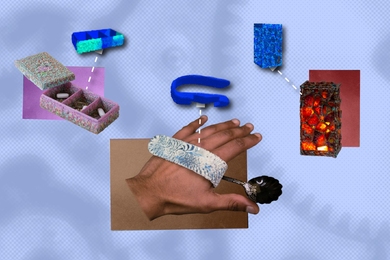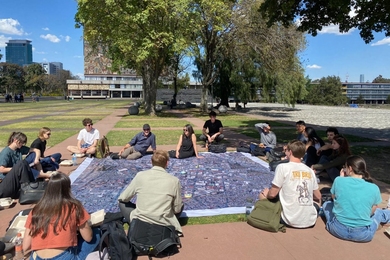By 2005, scientists expect to know the sequence of all 3 billion DNA building blocks (nucleotide base pairs) passed from one generation to the next in human reproduction. The framework for the "periodic table" of human inheritance--fitting comfortably on a CD-ROM--will be available to anyone capable of reading the four-letter DNA code that comprises the alphabet of life. What does this mean for science and society?
In the October 25 issue of Science magazine, Eric Lander, professor of biology and director of the Whitehead/MIT Center for Genome Research, explores the significance of this extraordinary new knowledge, proposes scientific and technical goals for future genome studies, and forecasts dramatic consequences for understanding life and curing disease. Among these consequences will be powerful new tools for studying cancer initiation and progression, the capacity to find the most "common variants" of all human genes (potentially revealing the secrets of disease susceptibility and creating broad new opportunities for preventive medicine), and unprecedented information about the origin and migration of human populations.
In the Science article, Professor Lander also calls for increased attention to the ethical, legal and social issues raised by rapid access to genetic information, and new public education projects. "In the not-too-distant future, individuals will be faced with the choice of whether to obtain global views of their own genomes and, along with their health care providers, will need to interpret that information," he said. "Today, we have a window of opportunity-we have to make the study of genetics more accessible so people will have the tools they need to make and understand these choices when they become available."
`PERIODIC TABLE'
The first complete sequence map of the human genome will satisfy the third of three major goals set in 1990 for the US Human Genome Project (HGP), coordinated jointly by the National Center for Human Genome Research (NCHGR) of the National Institutes of Health and the Department of Energy. The Whitehead/MIT Center for Genome Research is the largest component of the HGP sponsored by NCHGR and one of six centers nationwide selected to begin the task of sequencing the genome.
"The Human Genome Project is best understood as the 20th century's version of the discovery and consolidation of the periodic table," Professor Lander said. "Between 1869 and 1889, chemists realized that it was possible to systematically enumerate all atoms and to arrange them in an array that captured their similarities and differences. Ordering the building blocks of chemistry gave rise to the chemical industry and modern physics.
"The consequences of the Human Genome Project will be no less profound," he continued. "The aim is to produce biology's periodic table-not 100 elements, but 100,000 genes. Instead of the familiar rectangle we all remember hanging on the wall of our high school chemistry class, this periodic table of human biology will be a tree structure depicting the functional and ancestral relationships among all human genes."
An average gene consists of about 30,000 nucleotide base pairs and carries the instructions for making a single protein molecule. The genes are dispersed along the 23 pairs of chromosomes carried in the nucleus of every human cell (with the exception of egg and sperm cells, which carry half the total number of chromosomes). Very slight differences in the order or identity of nucleotide bases in a gene can make the corresponding protein molecule more or less effective, or disable it entirely as in the single-gene diseases sickle cell anemia and cystic fibrosis.
"The biologic periodic table will make it possible to define a unique `signature' for every gene, consisting of 20 well-chosen DNA base pairs," Professor Lander said. "Rapidly evolving technologies, comparable to those used in the semiconductor industry, will allow scientists to build detectors that trace hundreds or thousands of these gene signatures in a single experiment."
With today's genetic techniques, scientists can trace inheritance patterns to locate chromosomal regions harboring genes for common diseases such as diabetes, hypertension and schizophrenia, but the regions often exceed 10 million base pairs in length. Finding the relevant gene or genes within such a region may take years and require DNA from hundreds or thousands of individuals.
ROUTINE RESEQUENCING
"All of that will change dramatically in the post-genome world, when we have a complete sequence map," Professor Lander said. "Scientists will take DNA from a few dozen affected and unaffected individuals, resequence the suspect region of the genome for each person, and compare the results. Telltale signs of correlated variation-sequence changes that occur with greater frequency in the affected individuals-will rapidly reveal the disease gene."
Similarly, studies of cancer initiation and progression will involve large-scale resequencing of all known or suspected cancer-related genes in tumor and normal tissues. The results will uncover key steps in cancer progression and suggest new targets for anti-cancer drugs.
Another major goal for scientists in the post-genome world will be to identify the most common variants of human genes. While the human population exhibits vast genetic diversity, individual genes (especially the regions that code directly for parts of an essential protein molecule) generally have only a handful of common DNA spellings. reflecting the fact that modern humans descended from a relatively small population that underwent exponential explosion in evolutionarily recent time.
"Tantalizing examples suggest that common variants may hold the secrets to many disease susceptibilities," Professor Lander said. For example, the apolipoprotein E gene has three major variants (E2, E3 and E4) that explain a large fraction of the risk for Alzheimer's disease, as well as risk for cardiovascular disease. In addition, the Factor V, ACE and CKR-5 genes each have common variants associated with risk of blood clotting, heart disease, and resistance to HIV (the AIDS virus), respectively.
Within a decade, scientists will be able to establish a catalog of common variants for all human genes (by resequencing the genomes of 100 random individuals), Professor Lander predicted. When completed, this catalog will become a vital new tool for understanding disease susceptibility and establishing guidelines for disease prevention and diagnosis.
The nucleotide sequence map of all human chromosomes will also lay the foundation for other goals:
- Exploring how nature produces such diversity of form and function from the same basic repertoire of mammalian genes (through rapid de novo sequencing of genomes from other organisms ranging from elephants to mice, and direct comparisons with the human sequence map).
- Deciphering the logic of gene regulation (by simultaneously monitoring the expression of all genes in a cell over time, following a known stimulus).
- Creating interaction maps of genomes (reconstructing cellular machinery by determining how each protein in a cell interacts with other proteins).
SCIENCE AND SOCIETY
Professor Lander emphasized that these technical goals must be coupled with increased attention to the ethical, legal and social issues surrounding new DNA technologies.
"The sequence map and the developments that follow will give us tremendous new capabilities to diagnose, prevent, and treat disease, but the same information also has great potential for misuse," he says. "As genetic readouts increase in power and decrease in cost, the potential for intrusive applications will skyrocket."
Through its Ethical, Legal and Social Issues program (ELSI), the HGP has included the societal implications of genetics within its scope from the outset, Professor Lander said. But the increasingly rapid pace of change "will require acute scientific vision to foresee the problems ahead and propose safeguards."
He also called for greater attention to public education. "At present, the general public has limited knowledge of genetics and lacks accessible ways to learn more. Yet they must learn more to prepare for greater participation in their own health care and to contribute to the decisions that will face society as a whole, such as who should have access to genetic information. We need a distinct and expanded program of public education aimed at schoolchildren, the general public, physicians and genetic counselors to get ready for the changes ahead."
A version of this article appeared in MIT Tech Talk on November 6, 1996.





